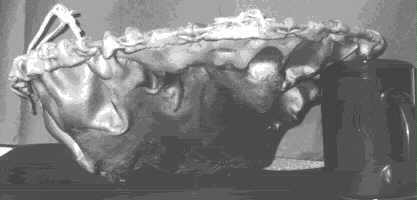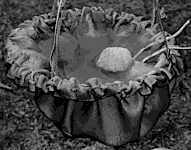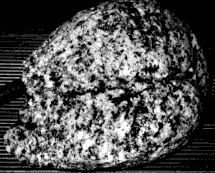Cooking "Clan of the Cave Bear" Style!
Trial One
The first trial was with the ugly pot. The objective in all trials
was to get water to boil. I filled it half full (4 litres).
After 38 minutes the water was steaming hot, but not boiling.
There was massive shrinkage of the pot, until the level of the
water was near the brim.
Trial Two
The good pot was filled initially with seven litres of water.
As it shrank I bailed out water to keep it from spilling over
onto the fire. The water became steaming hot after about 12 minutes,
but failed to boil over a trial time of one hour, thirty-seven
minutes. Shrinkage left it seriously misshapen as one side moved
up close to the plane of the ring.
 |
| Lopsided shrinkage in the 'good' pot |
This may have been due to un-uniform thickness of the rawhide circle the pot was made from. Hide varies in thickness, and on the half hide this pot was made from it was impossible to find a circle of this area that was uniform in thickness throughout. Also thickness varies from hide to hide. Since I didn't specify a thickness grade when ordering, Buckskin Leather sent me the two best they had available. The ugly pot was made from the thicker of the two, and that, coupled with its greater vertical proportion, may have contributed to its greater uniformity in shrinkage.
|
Trial Three
The ugly pot again. 3.5 litres of water. Again, water became steaming hot in short order, but failed to boil. We (myself, Betty, and friend Val) decided that it was hot enough to brew tea in, and created a tea bag from cheese cloth and chamomile. Popped it in at one hour, five minutes. |
 |
| Terminated trial at one hour, twenty-five minutes, still no boiling. The tea tasted distinctly of rawhide. Not terribly appetizing . | cheese cloth chamomile tea bag in 'ugly' pot |
Trial Four
 The method of cooking by putting hot rocks into a container (leather,
or mud slaked basketry) has been popular amongst diverse groups
of hunter-gatherers. The container can be as simple as a skin
pressed into a hole dug in the ground, or draped over a circle
of rocks. The latter is the method I chose to use for comparison
purposes with the pot-over-fire method.
The method of cooking by putting hot rocks into a container (leather,
or mud slaked basketry) has been popular amongst diverse groups
of hunter-gatherers. The container can be as simple as a skin
pressed into a hole dug in the ground, or draped over a circle
of rocks. The latter is the method I chose to use for comparison
purposes with the pot-over-fire method.
Sedimentary rocks should be avoided, since trapped moisture can
cause the rocks to explode when heated (Wilson, 1996; McParland, 1977). The
best rocks to use are igneous (though porous igneous can explode
since it contains gas pockets which expand when heated (Wilson,
1996)). Then there are the rocks which I used. A couple of them
were fine, but most were nice looking cobbles of the variety not
shown below.
 This is one of them after being heated and submerged.
Unless one fancies a high mineral content in one's diet, this
type of rock should be avoided. It didn't explode or shatter
(I wore safety goggles just in case), it crumbled. With transportation
and handling it has crumbled even more and seems to have totally
given up on continued existence as an integrated entity. It is
the metamorphic equivalent of granodiorite, though only slightly
metamorphosed so that one almost has to use one's imagination
to detect oriented bands of hornblende (the dark mineral) visible
after cracking, and it would be (was) a very tough call for a
novice rock seeker without first cracking the cobble. The white
portion is sodium feldspar, and the off-white/grey mineral is
quartz (Wilson, 1996). Further adding to its fragility is the
fact that it is weathered, and one can see the weathering rind
on a broken section. They, like so much of the material in this
experiment, were scavenged from around Rosewood Gardens, some
from the surface of the ground, others from a dirt pile produced
as a result of recent digging. Better would have been cobbles
protected from weathering by a stream, though these are susceptible
to tumbling which can create incipient fractures (small cones of percussion going into the material) in the surface,
which might
come apart if stressed (Wilson, 1996). Still, a cone fragment or two in the
stew would be better than a significant portion of crumbled metamorphic
equivalent of granodiorite.
This is one of them after being heated and submerged.
Unless one fancies a high mineral content in one's diet, this
type of rock should be avoided. It didn't explode or shatter
(I wore safety goggles just in case), it crumbled. With transportation
and handling it has crumbled even more and seems to have totally
given up on continued existence as an integrated entity. It is
the metamorphic equivalent of granodiorite, though only slightly
metamorphosed so that one almost has to use one's imagination
to detect oriented bands of hornblende (the dark mineral) visible
after cracking, and it would be (was) a very tough call for a
novice rock seeker without first cracking the cobble. The white
portion is sodium feldspar, and the off-white/grey mineral is
quartz (Wilson, 1996). Further adding to its fragility is the
fact that it is weathered, and one can see the weathering rind
on a broken section. They, like so much of the material in this
experiment, were scavenged from around Rosewood Gardens, some
from the surface of the ground, others from a dirt pile produced
as a result of recent digging. Better would have been cobbles
protected from weathering by a stream, though these are susceptible
to tumbling which can create incipient fractures (small cones of percussion going into the material) in the surface,
which might
come apart if stressed (Wilson, 1996). Still, a cone fragment or two in the
stew would be better than a significant portion of crumbled metamorphic
equivalent of granodiorite.
In his experimenting with heating and cooling rocks, Pat McParland (1977) discovered that "in general a rock could be heated and submerged as many as seven times" before breaking, and his experiment involved cold water each time. He notes that the figure could be higher if the water in the trials had been allowed to remain hot. This is an important factor in the consideration of efficiency (how many trips to the stream bed) of the method. The rocks I was using did not conform to his general rule.
The 'container' held 16 litres of water. I removed hot rocks
from the fire one at a time and deposited them into the container
using a shovel. After about twenty five minutes the water was
steaming hot, but not boiling. It was clear that my fire was too
small, that I didn't have enough cobbles to boil that much water,
and that the number I did have was diminishing due to crumbling.
We decided to halt for dinner. We had hoped to cook it in the
manner described in Clan of the Cave Bear (Auel, 1980), but, alas,
it was not to be. The stew was cooked in the kitchen (recipe
at end of this document), and desert was marshmallows roasted
on sticks of maple.
Trials continued on March 23, 1996, focusing primarily on the hot
rock method. Betty had the fire going prior to my arrival in the morning
and reported hearing a loud bang. One of the rocks that formed the
circle, a sedimentary, had split suddenly. Thus we learned that rock
selection is important for ring stones as well, not just rocks directly in
the fire.
The Icons below will guide you to the other Cooking Clan of the Cave Bear Style Pages |